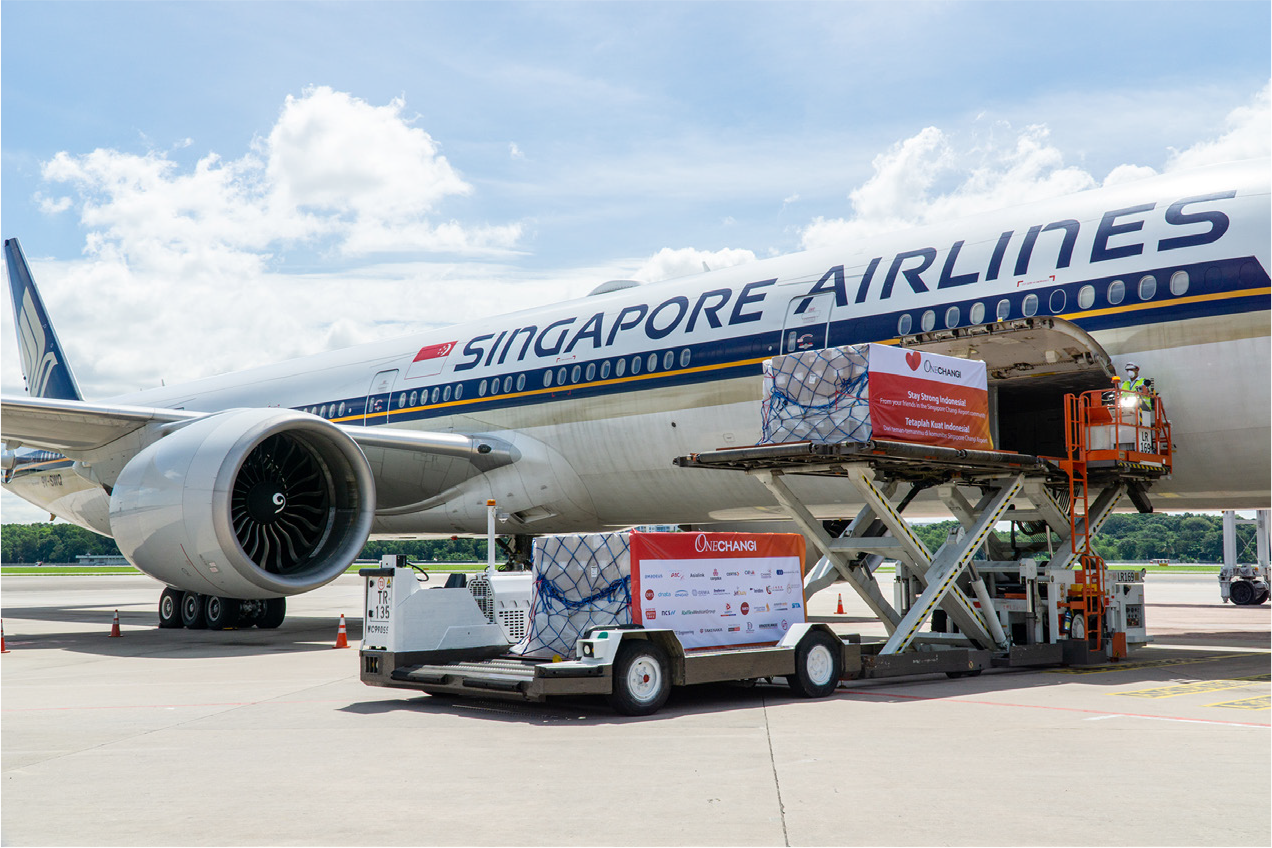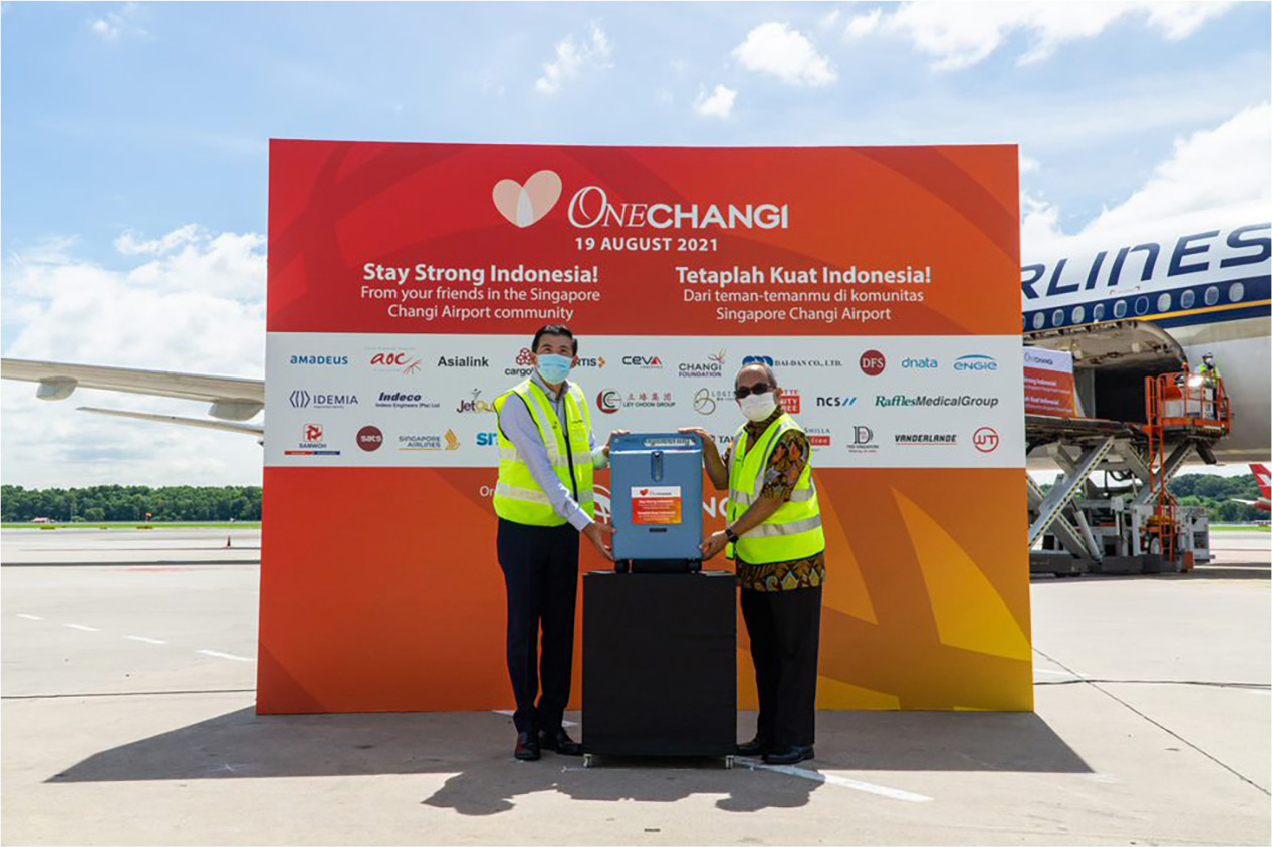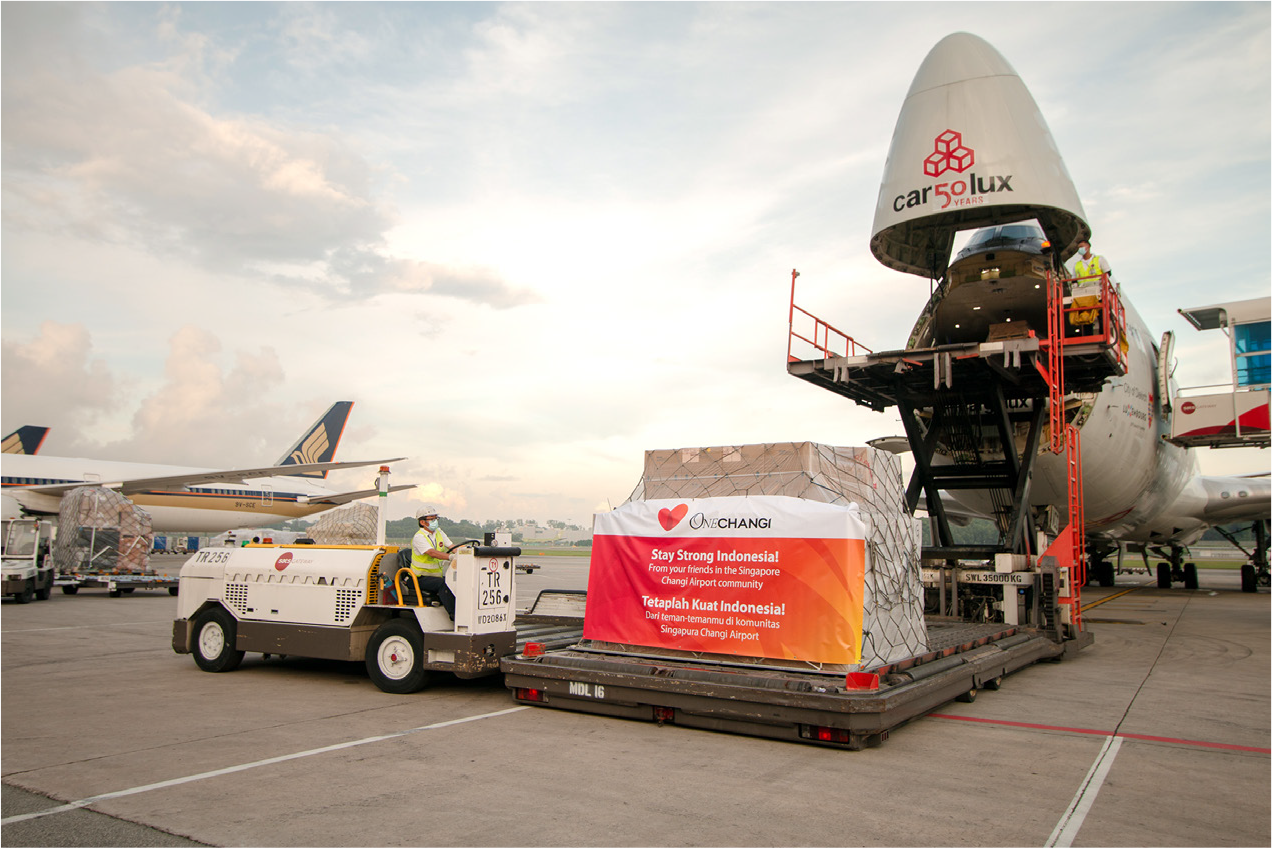

The Covid-19 pandemic continues to impact countries around the world, including in Southeast Asia, which has seen a large spike in Covid-19 cases recently due to the highly transmissible Delta variant.
In response to this unprecedented health crisis, the Changi Airport community has come together to support Indonesia in its fight against the pandemic by with the donation and delivery of 1,380 oxygen concentrators into the country. These concentrators are donated by Changi Foundation, the philanthropic arm of Changi Airport Group (CAG), together with over 30 other airport partners from a range of sectors including retail, engineering and construction, as well as many individual airport staff. CAG has worked closely with the Indonesian embassy in Singapore to facilitate this donation. The Indonesia Ministry of Health will deploy these oxygen concentrators to hospitals in the country, providing much-needed oxygen supplies to Covid-19 patients.
Changi’s air cargo partners have also readily stepped in to play a part in this humanitarian effort. Airline partners Cargolux and Singapore Airlines, along with, logistics partners SATS and CEVA Logistics supported the undertaking the shipment of the oxygen concentrators from Los Angeles to Singapore and onward to Jakarta.
The first shipment of oxygen concentrators arrived into Singapore from Los Angeles via Luxembourg onboard Cargolux’s scheduled freighter service CV7306 on 15 Aug 2021. The shipment of oxygen concentrators was delivered directly to the CEVA Logistics warehouse located within the Airport Logistics Park of Singapore. The shipment was further consolidated with locally sourced medical supplies before leaving Singapore for Jakarta onboard Singapore Airlines SQ964. SATS and its joint venture PT Jas teamed up Cargolux Airlines, Singapore Airlines and CEVA Logistics to undertake the shipment of the oxygen concentrators from Los Angeles to Singapore and onward to Jakarta.

Mr Lee Seow Hiang, Chief Executive Officer of CAG said, “Covid-19 has impacted everyone, and no country has been spared the effects of the pandemic. But no country should have to walk this battle path alone. I think this was what many of us had in mind when the Changi Airport community came together in a combined effort, to do our small part to help Indonesia, whom Singapore has close links with. I sincerely thank all our partners and contributors in this effort. We stand with the people of Indonesia during this difficult time and sincerely hope that our contribution will go some way towards saving precious lives.”
His Excellency Suryo Pratomo, Indonesian Ambassador to Singapore said, “This unprecedented situation requires solid communication and collaboration between us to fight the Covid-19 virus. No single country can fight this pandemic alone, so strong cooperation is needed. Indonesia and Singapore have showcased the true meaning of ‘a friend in need is a friend indeed’. I highly appreciate these oxygen concentrators donated by the Singapore Changi Airport community, which shows earnest support and understanding of our fight against Indonesia's pandemic. Thank you very much.”

2019冠病疫情持续影响世界各国,包括东南亚。由于Delta毒株传播迅速,近期以来该地区的确诊人数剧增。
为应对这一个前所未有的公共卫生危机,樟宜机场社群齐心协力,共捐助并运送1,380台医用制氧机给印尼,以支持该国抗击疫情。这些医用制氧机由樟宜机场集团的慈善机构樟宜基金会和超过30个来自零售、工程和建筑业的机场伙伴,以及众多机场工作人员捐助的。樟宜机场集团与印尼驻新加坡大使馆密切合作,以促使此次的捐助活动。印尼卫生部将把这些医用制氧机分配给该国的医院,为患者提供急需的氧气供应。
樟宜的航空货运合作伙伴也参与了这项善举。航空公司伙伴卢森堡航空和新加坡航空,以及物流合作伙伴新翔集团和CEVA物流将医用制氧机从洛杉矶经新加坡运送到雅加达。
第一批医用制氧机通过卢森堡航空的定期全货机航班CV7306,于2021年8月15日从洛杉矶经卢森堡抵达新加坡,并被直接运送到新加坡机场物流园区内的CEVA物流仓库。这批医用制氧机与其他本地采购的医疗用品在整合后通过新加坡航空SQ964从新加坡飞往雅加达。新翔集团及其合资企业PT Jas与卢森堡航空、新加坡航空和CEVA物流合作,承接从洛杉矶经新加坡到雅加达的医用制氧机运输。

樟宜机场集团总裁李绍贤表示: “疫情影响了每个人,没有一个国家可以幸免,但任何国家都不必孤军作战。我觉得当樟宜机场社群作出集体贡献协助与新加坡有密切关系的印尼时,就是基于这个理念。在这个艰难时刻,我们与印尼人民携手同战,诚心希望我们的捐助将有助于拯救宝贵生命。”
印尼驻新加坡大使SuryoPratomo说: “在这种前所未有的情况下,我们彼此之间需要紧密的沟通与合作,以对抗2019冠状病毒。任何一个国家都无法单独抗击这场疫情,而必须集体合作抗疫。我很感激樟宜机场社群捐助的医用制氧机,给予我们抗疫所需的支持和理解。患难见真情共同抗疫情,非常谢谢大家。”
1. What are some of the emerging trends and disruptions you have observed that will impact the global air cargo industry?
The pandemic has caused a shift in the way goods and services are being consumed. Consumers are moving their purchases online. According to the IATA June 2021 report, 18% of air cargo currently attributes to eCommerce, and the share is expected to rise to 22% by 2022.
The rapid growth in eCommerce puts much pressure on the global air cargo industry, which has been experiencing tight capacity since the beginning of the pandemic. IATA’s June 2021 report showed global cargo tonne-kilometres (CTKs) registered an increase of 8% compared to the same period in 2019 (pre-pandemic). We expect this uptrend to continue into 2022. The increased demand for air cargo is a driver for airlines to consider expanding their cargo capacity. Many airlines have been making use of the spare capacity in passenger aircraft for cargo-only operations. According to IATA, air cargo now represents 30-35% of airline revenue.
COVID-19 has also put pressure on industry players to accelerate their digitalisation plans. It is now evident that digitalisation is imperative to enabling a high level of efficiency to meet consumer expectations. Digital logistic platforms, automation and robotics, are no longer nice to have. They are important enablers that allow companies to grow, scale and compete as the air cargo industry evolves.
2. How would cargo handling evolve in the post-pandemic world?
The air cargo industry is rapidly evolving as large eCommerce players transform their businesses to better meet their consumers’ expectations. Technology adoption becomes imperative in enabling service providers like SATS to provide the critical data required for all stakeholders in the supply chain from shippers to integrators, logistics providers and airlines to make better operational and business decisions. Transparency enables all stakeholders in the ecosystem to fulfil customers' expectations of speedier delivery.
As eCommerce volume grows, implementing smart logistics with automated cargo facilities would be crucial for air cargo ground operations to keep pace with the fast-growing e-commerce demand. At the same time, the growth of eCommerce also raises the risks of having prohibited items ingested into the supply chain. Hence, we could expect new air cargo safety and security requirements that would impact how we handle cargo in the future.
The disruption to the supply chain brought about by the pandemic has created new opportunities for the airlines that could change the way airlines plan the frequency of flight operations for a particular route. In the near term, planning of passenger flights could be weighted almost equally based on the demand for cargo space and passenger volume.
3. Digitisation is no longer an option today. How is SATS (Cargo) staying at the forefront in the area of digitisation and innovation?
As a service provider, customer expectations and demands have always been the design considerations of our customer-facing processes and systems. Over the years, we have progressively built technological capabilities that enhance our cargo operations and strengthen our ability to meet new demands. For example, we see airlines capitalising on eCommerce growth to transform their operations to gain a more significant share of the door-to-door delivery market. SATS has invested in upgrading our fulfilment platform within our Cargo operating system to enable seamless handling of shipments through value-adding services, customs clearance, and integration with last-mile delivery providers.
Moving forward, we will focus more on developing a data-driven ecosystem around the needs of our customers. Meeting this need will bring agility and efficiency into the present and future operations and help strengthen Singapore’s position as a global air cargo hub.

1. 根据您的观察,有哪些新兴的趋势和颠覆将影响全球航空货运业?
疫情已改变了商品和服务的消费方式。消费者已逐渐转向网上购物。根据国际航空运输协会2021年6月的报告,目前有18%的航空货运量来自于电子商务; 预计到2022年,这个比例将上升至22%。
全球航空货运业自疫情开始以来一直处于运力紧张的状态,而电子商务的快速增长也对该行业带来很大的压力。国际航空运输协会2021年6月的报告显示,全球货运吨公里(CTK)与2019年同期(疫情前)相比增长了8%。我们预计这种上升趋势将持续到2022年。航空货运需求的增加是对航空公司考虑扩大其货运运力的驱动因素。许多航空公司一直在利用客机的剩余运力进行货运业务。根据国际航空运输协会表示,目前航空货运占航空公司收入的30-35%。
2019冠病疫情也促使业者加快他们的数码化计划。不可置疑的,如今数码化对于实现高效率以满足消费者的期望至关重要。数字物流平台、自动化和机器人技术已不再是可有可无的,而是能使公司随着航空货运业的进化发展业务、扩大规模并有效竞争的重要推动因素。
2. 在疫情后,货运地勤服务业将会如何发展?
随着大型电子商务公司转变其业务以更好地满足消费者的期望,航空货运业也正在迅速演变。技术的采用已不可或缺。对于让新翔等服务提供商能够为从托运人到快递物流集成商、物流提供商和航空公司的供应链中的所有利益相关者提供所需的关键数据,以做出更好的运营和业务决策。透明度可为生态系统中的所有利益相关者满足客户对更快交货的期望。
随着电子商务量的增长,为了跟上快速增长的电子商务需求,以自动化货运设施推行智能物流对于航空货运地面运营来说极为重要。与此同时,电子商务的发展也增加了被禁物品流入供应链的风险。因此,想必会有新的航空货运安全和安保要求,而这将影响我们未来处理货物的方式。
疫情对供应链造成的中断也为航空公司制造新良机,可能会改变航空公司对特定航线的飞行计划。在短期内,货舱和客运量两者需求可能会对客运航班的规划有几乎一样的影响。
3. 如今,数据化已经是势在必行。新翔(货运)如何在数码化和创新领域保持领先地位?
作为服务提供商,客户的期望和需求一直是我们面向客户的流程和系统的设计考量。多年来,我们逐步建立了技术能力,以提高货运业务,并增强满足新需求的能力。例如,我们见证了航空公司利用电子商务的增长来转变其运营,以获得更重要的门到门交付市场份额。新翔集团已投资升级我们的航空货运操作系统中的履行平台,与最后一英里交付提供商提供系统集成带来无缝处理货物、增值及清关服务。
接下来,我们将更加专注于针对客户需求开发数据驱动的生态系统。只要能满足这一项需求,就能将当前和未来的运营带来敏捷性和效率,并有助于巩固新加坡作为全球航空货运枢纽的地位。
